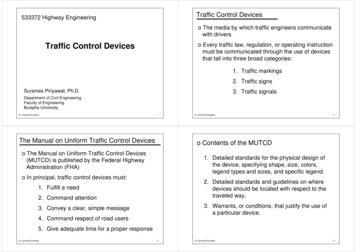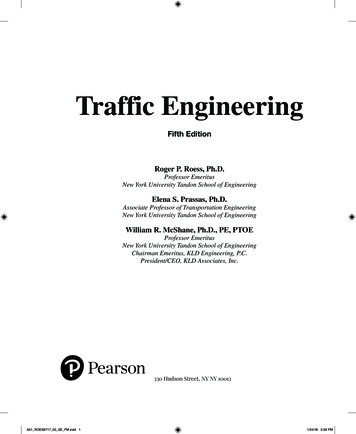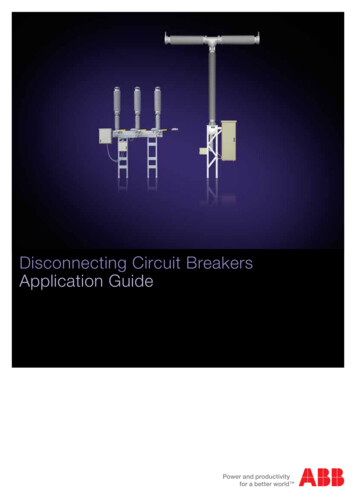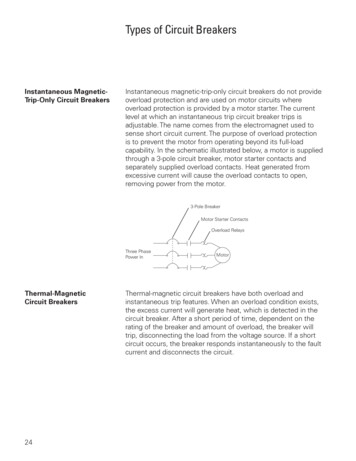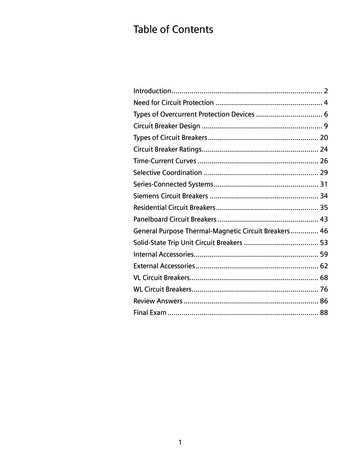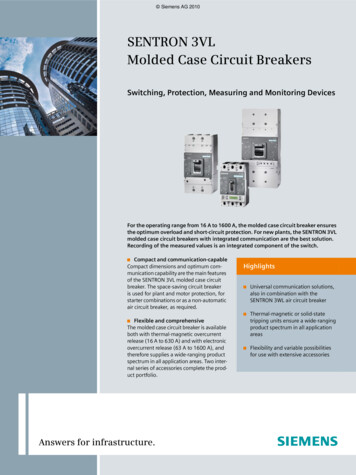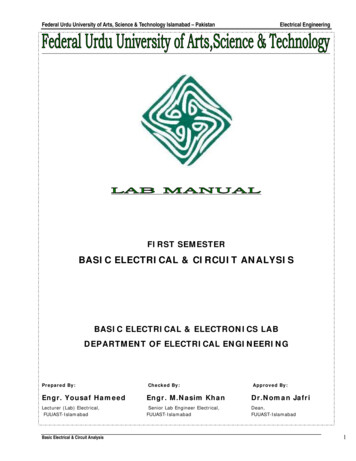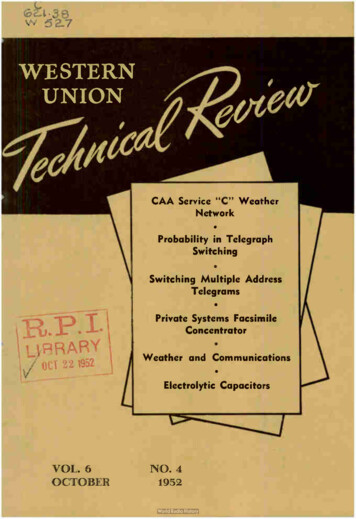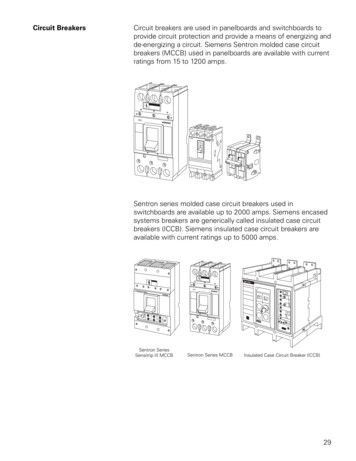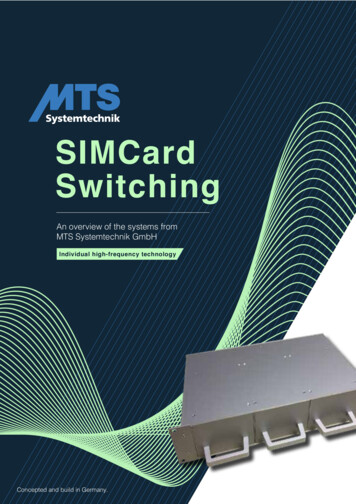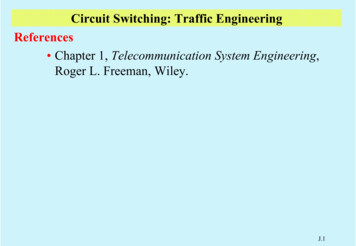
Transcription
Circuit Switching: Traffic EngineeringReferences Chapter 1, Telecommunication System Engineering,Roger L. Freeman, Wiley.J.1
Introduction: mesh and starExample:– mesh connection (full mesh) for an eight-subscriber system– justify a mesh connection is when each and every subscriber wishesto communicate with every other subscriber in the network forvirtually the entire day. Most subscriber do not use their telephones on a full-time basis the ordinary subscriber will normally talk to only one othersubscriber at a timeJ.2
Introduction: mesh and star– Star network with a switch at the center switch reduce the number of links between subscribers4?3?2?1?J.3
TerminologyTerminology– Trunk the telephone lines connecting one telephone switch orexchange with another are called trunks.– Calling rate (C) The number of calls which arrive over a time interval¾Call per unit time– Holding time (H) The average duration of a callJ.4
Busy hourTelephone traffic may fluctuate throughout the day, andmay have a “busy hour” which is the hour that has themost number of calls busy hour depends on various factors such as stockmarket, weather and international eventsJ.5
Measurement of Traffic– The traffic intensity, more often called the traffic, is defined as theaverage number of calls in progress.Unit: Erlang (E)A Ch / TA: traffic intensityC: number of calls arrivals during time Th: average holding time Example: A single trunk¾cannot carry more than one call, i.e., A 1 for one trunk.¾The probability of finding the trunk busy is equal to theproportion of time for which the trunk is busy. Thus, thisprobability equals the occupancy (A) of the trunk.J.6
Measurement of TrafficExample: 1.5 erlang of traffic carried on three trunksTrunk 1Trunk 21.5ETrunk 3timeBusyFreeJ.7
Measurement of TrafficExample: On average, during the busy hour, a companymakes 120 outgoing calls of average duration 2 minutes. Itreceives 200 incoming calls of average duration 3 minutes.Find the outgoing traffic, the incoming traffic and thetotal traffic.SolutionA Ch / Twhere T 1 hour 60 minutesOutgoing traffic 120 calls x 2 minutes/ 60 minutes 4 EIncoming traffic 200 calls x 3 minutes/ 60 minutes 10 ETotal traffic 4 E 10 E 14 EJ.8
Measurement of TrafficExample:During the busy hour, on average, a customer with asingle telephone line makes three calls and receives threecalls. The average call duration is 2 minutes. What is theprobability that a caller will find the line engaged?Total traffic Occupancy of line (3 3) x 2 / 60 0.1 EProbability of finding the line engaged 0.1J.9
Blockage, Lost Calls, and Grade of ServiceLost call or blocked calls– In a circuit-switched system, all attempts to make callsover a congested group of trunks are unsuccessful. Theunsuccessful call is called lost call or blocked call.Grade of service– probability of meeting blockage is called the grade ofservice (B)– Example: On average, one call in 100 will be blocked B 0.01J.10
Blockage, Lost Calls, and Grade of Service– Grade of service is also the proportion of the time for which congestion exists probability of congestion probability that a call will be lost due to congestion– If traffic A Erlangs is offered by a group of trunks havinga grade of service B, the traffic lost is AB and the trafficcarried is A(1-B) erlangs.AA-ABABJ.11
Blockage, Lost Calls, and Grade of ServiceExampleDuring the busy hour, 1200 calls were offered to a groupof trunks and six calls were lost. The average callduration was 3 minutesThe traffic offered A C1h/T 1200 x 3 /60 60 EThe traffic carried C2h/T (1200-6) x 3 / 60 59.7 EThe traffic lost B C3h/T 6 x 3 / 60 0.3 EGrade of service B/A 0.3 / 60 0.005The total duration of the periods of congestion B x T 0.005 x 3600 18 secondsJ.12
Traffic FormulasModels of trafficσ2– Variance-to-mean ratio (VMR) α ¾Smooth: VMR 1µJ.13
Traffic Formulas Rough: VMR 1 Random: VMR 1 Poisson distributionfunction is an exampleof random traffic whereVMR 1J.14
Traffic Formulas– The number of call arrivals in a given time has a Poisson distributionP( x) µxe µx! x is the number of call arrivals in time T µ is the mean number of call arrivals in TP(x)x P(x)– Example: µ 30.2500.0510.150.2230.220.220.154 0.17560.110.0570.0240.010.10.050012345678xJ.15
Traffic Formulas– Call-holding time is modeled by a negative exponentialdistributionP (T t ) e t / h P is the probability of a call lasting longer than t h is the mean call duration Example: h 3 minutes10.9P (T t )0.80.70.60.50.40.30.20.10012345t678910J.16
Traffic FormulasExample: On average one call arrives every 5 seconds.During a period of 10 seconds, what is the probability thatxµa. No call arrivesP( x) e µµ 2 calls/10 secondsx!2 0 2P(No call arrives) P ( x 0) e 0.1350!b. One call arrives21 2P (1) e 0.271!c. More than one call arrivesP ( x 1) 1 P (0) P (1) 0.595J.17
Traffic FormulasExample: In a telephone system, the average call duration is2 minutes. A call has already lasted 4 minutes. What is theprobability thata. the call will last at least another 4 minutesThe probability is independent of the time which asalready elapsed.P (T 4) e t / h e 4 / 2 0.135b. The call will end within the next 4 minutesP (T 4) 1 P (T 4) 1 0.135 0.865J.18
Lost-call systemsConsider that a large number of local loops are served bya small number of trunks in an exchangeTrafficofferedA erlangsN outgoingtrunkswhen a call demanding a trunk link arrives, it is assigneda free trunk line if one is available, but if all trunks areengaged, that call will be lost since no provision ofbuffering is made.J.19
Erlang’s lost-call formula– For a lost-call system having N trunks, when offeredtraffic A, the first Erlang distribution is given byAxP ( x) N x! kA k 0 k! x is the number of occupied trunks P(x) is the probability of x occupied trunks– The probability of a lost call, which is the grade of serviceB, isB P (N )J.20
Erlang’s lost-call formulaExampleA group of 5 trunks is offered 2 E of traffic. Finda. The grade of service25AN0.2667!5!NB P( x N ) N k 5 k 0.0377.26672A !kk 0 k!k 0b. The probability that only one trunk is busy2121!P(1) N k 0.275A7.2667 k 0 k!J.21
Erlang’s lost-call formulac. The probability that only one trunk is free2416 / 24P(4) N 4! k 0.0917A7.2667 k 0 k!d. The probability that at least one trunk is freeP ( x 5) 1 P (5) 1 B 1 0.037 0.963J.22
Traffic TableTU:trafficunitJ.23
Traffic TableExampleOn average, during the busy hour, a company makes 120outgoing calls of average duration 2 minutes. It receives 200incoming calls of average duration 3 minutes. This companywishes to obtain the grade of service of 0.01 for bothincoming and outgoing calls. How many exchanges linesshould it rent ifa. Incoming and outgoing calls are handled on separategroups of linesb. A common group of lines is used for both incoming andoutgoing calls.J.24
Traffic Tablea.The outgoing traffic is 120 x 2 / 60 4 EThe incoming traffic is 200 x 3 / 60 10 EFrom the table,4 E of outing traffic needs 10 lines10 E of incoming traffic needs 18 linesb.The total traffic is 14 EFrom the table,14 E of traffic needs 23 linesJ.25
C: number of calls arrivals during time T h: average holding time Example: A single trunk ¾cannot carry more than one call, i.e., for one trunk. ¾The probability of finding the trunk busy is equal to the proportion of time for which the trunk is busy. Thus, this probability equals the occupancy (A) of the trunk. A Ch /T A 1

